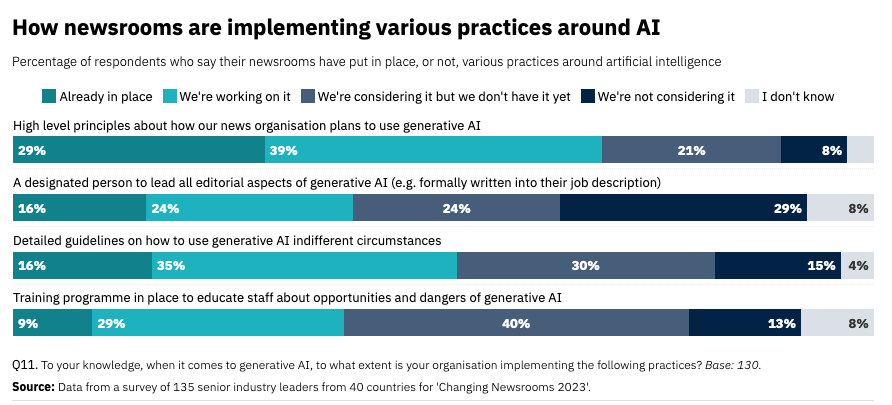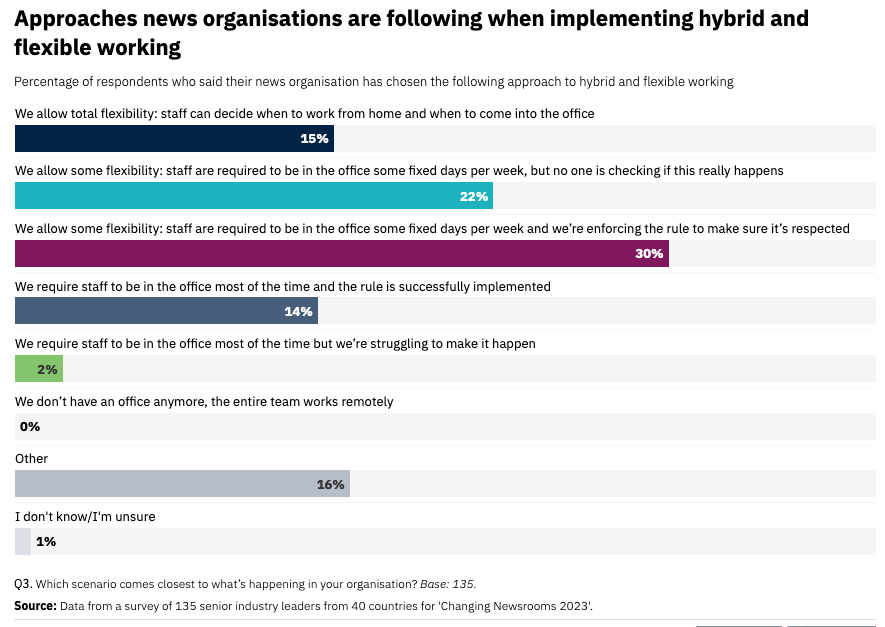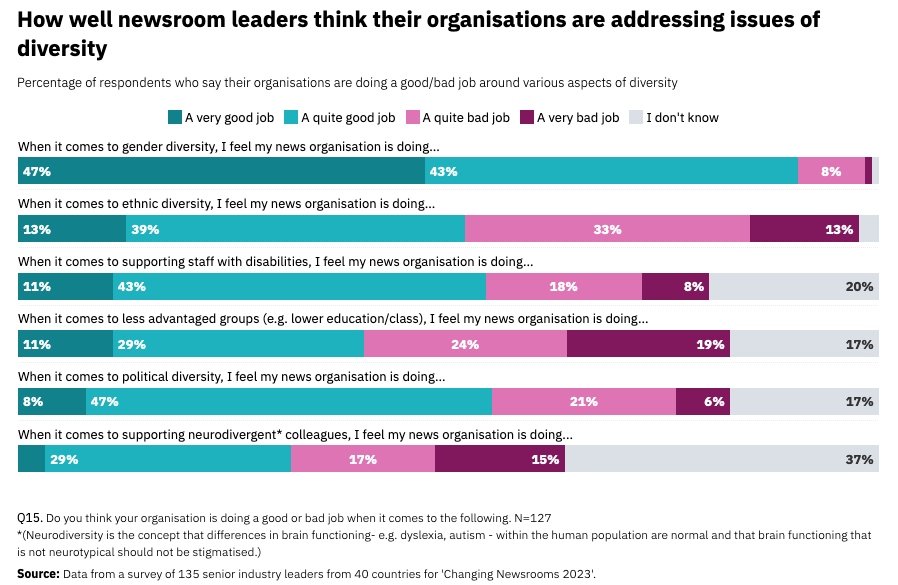
Generative AI, flexible working and diversity are the three pressing topics on the minds of top news leaders, according to a new study, Changing Newsrooms 2023, by the Reuters Institute for the Study of Journalism (RISJ).
This third annual study conducted surveys with 135 senior industry leaders from 40 countries and 10 in-depth interviews to gauge how newsrooms are responding to new challenges. It also ties in new ideas and revelations from other industries and sectors.
The very top news leaders recognise that all three challenges are complicated, but are willing to formalise processes to test and learn new ideas.
"Those choosing systemic approaches are just in a stronger position because they are better able to evaluate risks and opportunities," says Federica Cherubini, director of leadership development at RISJ and co-author of the report.
Generative AI: dipping a toe in, not jumping in at the deep end
Generative AI has burst into the mainstream thanks to ChatGPT's arrival in 2022, raising questions about how information is created and consumed. There are some obvious benefits to using the tech, but the media remain largely cautious.
Three quarters of news leaders think the tech will help newsrooms increase productivity and improve workflows, without affecting its journalism.
Just two per cent have not bought into the hype and said it will not impact their journalism, while one fifth believe it will fundamentally change every role in the newsroom.
With little industry consensus on how to adopt generative AI though, a minority of newsrooms have developed internal supportive structures for journalists. Those include high-level principles (29 per cent), in-house experts (16 per cent), guidelines (16 per cent) and training (9 per cent).
Not everyone is sold on these ideas though. Strikingly, 29 per cent of respondents said they were not considering having a designated person to lead all editorial aspects of generative AI.

Screenshot: Reuters Institute's Changing Newsrooms 2023 study
At Swedish Radio, Olle Zachrison, formerly the news commissioner, became head of artificial intelligence last month. He also heads up a company-wide AI council with 10 colleagues, reporting to the director general and CEO Cilla Benkö.
The aim is to identify the best applications for the tech, stay on top of emerging ethical and legal discussions, and introduce learning activities for staff. By taking such a systemic approach, the organisation wants to be more proactive than reactive.
Flexible working: recruitment vs retention, productivity vs presenteeism
Conversely, nearly two thirds of newsrooms have moved towards flexible and remote working since covid-19, building in specific policies and processes.
That said, 16 per cent have gone back to the pre-pandemic norm of majority office hours. Perhaps not surprisingly, two per cent said they have mandated staff to return to the office but struggle to make it happen.

Screenshot: Reuters Institute's Changing Newsrooms 2023 study
One respondent from a German broadcaster said: "My organisation has spiralled back into a mostly in-office policy, which has had a negative impact on retention. A lot of people have left seeking more flexible work arrangements. Our schedules at the news desk aren’t flexible at all time-wise, thus people seek out flexibility in terms of where to work, which we don’t offer."
The talent question still lingers. More than half (52 per cent) say that flexible working has made recruitment easier. But this can come at the cost of retention. A third (28 per cent) feel working remotely has weakened their sense of belonging, making them feel disconnected from decision-making and miss out on opportunities or recognition.
There are also the two linked challenges around productivity and presenteeism, and the jury is still out on both. Half (48 per cent) think productivity has neither increased nor decreased, with efforts to measure this resorting to visibility and activity metrics. As a result, staffers feel the pressure to be responsive to messages at all times.
News leaders are split between putting some or a lot of effort (52 per cent), or little or none (46 per cent) effort into measuring productivity. A more useful alternative to activity metrics is needed, such as goals and key performance indicators (KPIs).
Diversity: interventions needed
Flexible work does have another considerable upside - improving diversity in newsrooms.
More than half (57 per cent) of news leaders think offering this helps to recruit and retain working parents, women, caregivers and those from lower socio-economic groups.
There is room for improvement though, as news leaders admit they could be doing a better job in supporting various diverse groups: gender (9 per cent), ethnicity (46 per cent), disabilities (26 per cent), disadvantaged groups (43 per cent), political (27 per cent), and - new to the study - neurodiversity (33 per cent).

Screenshot: Reuters Institute's Changing Newsrooms 2023 study
Commitment to diversity skews much more favourably towards the junior level, where 86 per cent of news leaders think they are doing well. This gets progressively worse at higher levels of the organisations, as only 45 per cent of news leaders feel the same about diversity at senior leadership.
Is offering flexible work enough to retain diverse talent? Hardly. Diversity is not the same as inclusion, so something like flexible work cannot alone fix dysfunctional or dominant newsroom culture. More needs to be done to foster a sense of belonging for those brought into the newsroom.
Also, without clear and specific diversity initiatives, newsrooms will tend to revert to the status quo. Just a fifth (22 per cent) of news organisations reported having a formal system for diversity retention, while a third (30 per cent) say their organisation is not addressing the topic at all.
What could this look like? Canada's The Globe and Mail provides some suggestions: a six-week sprint challenging journalists to discover new diverse sources; committing 30 per cent of the freelance budget to new writers; recruiting a standards editor, an empathy coach, newsroom advocates and a newsroom development leader. These are just a few examples mentioned in the report.
There is also the UK's Bureau of Investigative Journalism, which under the new leadership of Rozina Breen, has pushed for new diversity efforts, to name a few: DEI-related KPIs and appraisal objectives, running community journalism initiatives and fellowships for underrepresented groups, source audits and trans-awareness training.
"If our default is maintaining that things should not change, then I don't think that bodes well for the news industry," concludes Cherubini.
Free daily newsletter
If you like our news and feature articles, you can sign up to receive our free daily (Mon-Fri) email newsletter (mobile friendly).
Related articles
- How to get started with user needs: learnings from the Reuters Institute, Metro.co.uk and smartocto
- A one-stop shop of mental health resources for journalists
- Headlines Network publishes new mental health resource on hybrid work
- Black Ballad hits a decade: 'Our priority will always be our community'
- Recruiting for inclusion: a guide for media organisations









